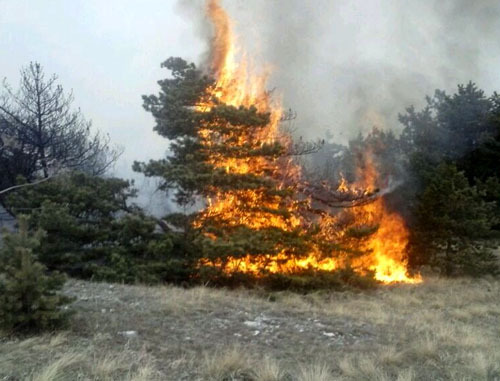
Dagestani Authorities Employ Collective Punishment in Fight Against Rebels
Publication: Eurasia Daily Monitor Volume: 11 Issue: 59
By:

Over three days, 11 people were killed in special operations in Dagestan. Ten of them were identified as members of the armed resistance, while the eleventh casualty was a member of the security forces. Two other servicemen were injured (https://dagestan.kavkaz-uzel.ru/articles/240005/).
On March 23, militants attacked a police patrol car on the Ametkhan Sultan Boulevard in Dagestan’s capital, Makhachkala. According to rebel sources, a car driven by rebels approached the police patrol and opened fire on them. One of the attackers was killed while the rest managed to escape. No information is available about police losses (https://vdagestan.com/obstrel-pps-v-shamilkale-byv-maxachkala.djihad). Independent sources confirmed insurgents carried out the attack (https://www.kavkaz-uzel.ru/articles/239922/).
On March 24, police in the city of Khasavyurt, chased a car that allegedly ignored a police order to stop, leading to a shootout in which those in the car were killed. This type of incident has become common in the region over the past several years. This particular incident took place when police overtook the car near 204 Toturbiev Street and people inside opened fire with a handgun and attempted to escape. The government forces then opened fire on the car and killed all four people in it (https://kavkazpress.ru/archives/43970). Two of the slain men were identified as active members of the armed underground movement—20-year-old Ismail Kazanbiev and 25-year-old Idris Akavov. The other two, 34-year-old Zurap Daudovich and 43-year-old Magomedgaji Askhabomarov, were thought to be rebel accomplices, but not active members of the jamaat (https://www.kavkaz-uzel.ru/articles/239959/). According to the authorities, Akavov was the leader of the Babayurt jamaat. Sources close to the Dagestani armed resistance quickly confirmed the official information (https://vdagestan.com/boj-v-xasavyurte.djihad).
A battle in the suburban Khasavyurt town of Pervomaiskoe on March 25 was an important event for Dagestani insurgents. A large government force that included personnel from the Russian security services and the republican interior ministry blockaded five militants in a house in Pervomaiskoe. When the militants were offered a chance to surrender, they started shooting. The insurgents claim that one serviceman was killed and two others wounded. However, the militants’ losses were far greater than the government’s. The emir of the Khasavyurt jamaat, 26-year-old Tural Ataev (a.k.a. Emir Yahya), was killed in the battle along with four other rebels—Shamil Yahyaev, Ahmet Yahyaev, Ahmed Magomedov and Gasan Dalgatov (https://kavkazcenter.com/russ/content/2014/03/25/103736.shtml). The other two people killed in the house have not been identified. These losses were also quickly confirmed by the insurgents.
According to Russia’s National Antiterrorist Committee (NAK), the slain emir, Yahya, was one of the organizers of the terrorist attack in the city of Pyatigorsk in December 2013 (https://newsru.com/russia/25mar2014/kto.html). This would be a plausible explanation had police not already killed the organizers of the Pyatigorsk attack back on January 15, also in Khasavyurt. At the time, the police said that they had killed a group of militants, including the ringleader of the Khasavyurt militancy, Marat Idrisov. The authorities accused Idrisov of organizing the December 2013 attack in Pyatigorsk (https://www.aif.ru/incidents/1083127). Separately, six people were detained in connection to an attack on a road police detachment in Pyatigorsk back on December 27 (https://www.gazeta.ru/social/news/2014/01/10/n_5867445.shtml). Thus, it appears this was one of those cases in which the police accuse those they kill of being behind a terrorist attack in order to beef up the significance of the operation.
The death of the Khasavyurt jamaat’s emir is a heavy loss for the militants. After Makhachkala, the Khasavyurt jamaat is ranked as the second most robust rebel unit. Of course, the leader of the jamaat will be replaced by one of his closest aides, the first naib, but there is no guarantee that the new leader will have all the connections to all of the jamaat’s cells. If the naib did not have links to the cells, the new emir will need time to reestablish ties with the rebel cells at the local level.
Another challenge for the leaders of both the Khasavyurt jamaat and the Dagestani jamaat as a whole will be to find out if the security services planted a mole in their ranks. Given that the authorities were able to locate Emir Yahya, it may mean that one of the people in his inner circle betrayed him.
The Dagestani jamaat is today not only the strongest, but also the largest among all the others in the North Caucasus. Thus, it is not surprising that the authorities will apply maximum energy and resources to suppress it. They will try to pit the general population against the insurgents through the mechanism of collective punishment, as happened in Dagestan’s Gumbetovsky district, where the government set the forests on fire. The forests have been burning since March 17 and government forces prevented locals from extinguishing the fire, citing the ongoing special operation. If the fire is not put out, the local forests may disappear completely (https://dagestan.kavkaz-uzel.ru/articles/240026/). The government is punishing the entire local population for refusing to give up the rebels—taking reprisals against entire villages for non-cooperation.
By creating conflicts within the local society through the use of collective punishment, the Dagestani authorities are seeking to marginalize the rebels among ordinary residents of the republic’s villages and cities. This, however, is unlikely to yield any results in the near term, given that Dagestani society does not perceive the rebels as their enemies even though it does not support their methods. The insurgents are seen as fighting against the unpopular policies of the regional and national governments.




